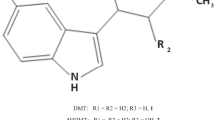Abstract
The ability of mono- and dicationic phenylcyclohexyl derivatives, which are non-competitive glutamate antagonists, to prevent convulsions induced in mice by intragastric NMDA or kainate, to weaken catalepsy induced in rats by haloperidol, and to exert their own influences of movement activity and behavior in animals was studied. The actions of study compounds were compared with those of the known NMDA antagonists memantine and dizocilpine. NMDA-induced convulsions were effectively prevented by both mono- and dications, while only dications were effective against kainate convulsions. Anticataleptic activity was significantly more marked in monocations, which lacked the ability to block non-NMDA receptors. Side effects on motor coordination were less marked with study compounds than with dizocilpine. Thus, the effects of phenylcyclohexyl derivatives in in vivo experimental models correlate with their anti-NMDA and anti-AMPA activity. They can be regarded as potential agents for treating parkinsonism and other motor disorders.
Similar content being viewed by others
REFERENCES
L. G. Magazanik, K. V. Bol'shakov, S. L. Buldakova, V. E. Gmiro, N. A. Dorofeeva, N. Ya. Lukomskaya, N. N. Potep'eva, M. V. Samoilova, D. B. Tikhonov, I. M. Fedorova, and E. V. Frolova, “Structural characteristics of ionotropic glutamate receptors, identified by channel blockade,” Ros. Fiziol. Zh. im. I. M. Sechenova, 86, 1138–1151 (2000).
N. I. Rukoyatkina, L. V. Gorbunova, V. E. Gmiro, and N. Ya. Lukomskaya, “The ability of glutamate receptor antagonists to ameliorate experimental catalepsy in rats,” Ros. Fiziol. Zh. im. I. M. Sechenova, 86, No. 6, 626–634 (2000).
A. Bissago, P. Krzascik, E. Jankowska, W. Palejko, W. Kostowski, and W. Danysz, “Effect of glutamate receptor antagonists on NMDA-and AMPA-induced convulsant effects in mice and rats,” Eur. J. Pharmacol., 242, 213–220 (1993).
W. Danysz and C. G. Parsons, “N-methyl-D-aspartate receptors: physiological significance and possible therapeutic applications,” Pharmacol. Rev., 50, 597–664 (1998).
P. J. Elliott, S. P. Close, D. M. Walsh, A. G. Hayes, and A. S. Marriott, “Neuroleptic-induced catalepsy as a model of Parkinson's disease. II. Effect of glutamate antagonists,” J. Neural. Transm., (Section P-D), 2, 91–100 (1990).
M. Gossel, W. J. Schmidt, W. Loscher, W. Zajaczkowski, and W. Danysz, “Effect of coadministration of glutamate receptor antagonists and dopaminergic agonists on locomotion in monoamine-depleted rats,” J. Neural Transm., (Section P-D), 10, No. 1, 27–39 (1995).
J. T. Greenamyre and R. H. P. Porter, “Anatomy and physiology of glutamate in CNS,” Neurology, 44, Suppl. 8, S7–S13 (1994).
T. Klockgether, L. Turski, T. Honore, Z. Zhang, D. M. Gash, R. Kurlan, and J. T. Greenamyre, “The AMPA receptor antagonist NBQX has antiparkinsonian effects in monoamine-depleted rats and MPTP-treated monkeys,” Ann. Neurol., 30, 717–723 (1991).
P.-A. Loschmann, K. W. Lange, M. Kunow, K.-J. Rettig, P. Jahnig, T. Honore, L. Turski, H. Wachtel, P. Jenner, and C. D. Marsden, “Synergism of the AMPA-antagonist NBQX and the NMDA-antagonist CPP with L-DOPA in models of Parkinson's disease,” J. Neural Transm., (Section P-D), 3, 203–213 (1991).
P.-A. Loschmann, U. Wullner, M. T. Heneka, J. B. Schulz, M. Kunow, H. Wachtel, and T. Klockgether, “Differential interaction of competitive NMDA and AMPA antagonists with selective dopamine D1 and D2 agonists in rat model of Parkinson's disease,” Synapse, 26, No. 4, 381–391 (1997).
M. R. Luquin, J. A. Obeso, J. Laguna, J. Guillen, and J. M. Martinez-Lage, “The AMPA receptor antagonist NBQX does not alter the motor response induced by selective dopamine agonists in MPTP-treated monkeys,” Eur. J. Pharmacol., 235, 297–300 (1993).
L. G. Magazanik, S. L. Buldakova, M. V. Samoilova, V. E. Gmiro, I. R. Mellor, and P. N. R. Usherwood, “Block of open channels of recombinant AMPA receptors and native AMPA/kainate receptors by adamantane derivatives,” J. Physiol. (London), 505, 655–663 (1997).
J. May, Z. Rogoz, G. Skuda, and T. Jaros, “Some behavioral effects of CNQX and NBQX, AMPA receptor antagonists,” Pol. J. Pharmacol., 47, No. 4, 269–277 (1995).
A. Mele, D. N. Thomas, and A. Pert, “Different neural mechanisms underlie dizocilpine maleate-and dopamine agonist-induced locomotor activity,” Neurosci., 82, No. 1, 43–58 (1998).
M. Morelli, S. Fenu, A. Pinna, and G. Di Chiara, “Opposite effects of NMDA receptor blockade on dopaminergic D1-and D2-mediated behavior in the 6-hydroxydopamine model of turning: relationship with c-fos expression,” J. Pharmacol. Exp. Ther., 260, 402–408 (1992).
K. Ossowska, “The role of excitatory amino acids in experimental models of Parkinson's disease,” J. Neural Transm. (section P-D), 8, No. 1-2, 39–71 (1994).
C. G. Parsons, W. Danysz, and G. Quack, “Glutamate in CNS disorders as target for drug development: an update,” Drugs News Prospects, 11, No. 9, 523–569 (1998).
C. D. Parsons, W. Danysz, and G. Quack, “Memantine is a clinically well tolerated N-methyl-D-aspartate (NMDA) receptor antagonist - a review of preclinical data,” Neuropharmacol., 38, 735–767 (1999).
J. J. Schuller and J. F. Marshall, “Intrastriatal DNQX induces rotation and pallidal fos in the 6-OHDA model of Parkinson's disease,” Neuroreport, 6, No. 18, 2594–2608 (1995).
B. Stauch-Slusher, K. C. Rissolo, K. F. Anzilotti, Jr., and P. F. Jackson, “Centrally administrated AMPA antagonists increase locomotion in parkinsonian rats,” J. Neural Transm. (section P-D), 9, No. 2-3, 145–149 (1995).
R. D. Sturgeon, R. G. Fessler, and H. Y. Meltzer, “Behavioral rating scales for assessing phencyclidine-induced locomotor activity, stereotyped behavior and ataxia in rats,” Eur. J. Pharmacol., 59, 169–179 (1979).
D. B. Tikhonov, M. V. Samoilova, S. L. Buldakova, V. E. Gmiro, and L. G. Magazanik, “Voltage-dependent block of native AMPA receptor channels by dicationic compounds,” Brit. J. Pharmacol., 126, 265–274 (2000).
L. Verhagen-Metman, P. Del-Dotto, P. van den Munckhof, J. Fang, M. M. Mouradien, and T. N. Chase, “Amantadine as treatment for dyskinesias and motor fluctuations in Parkinson's disease,” Neurology, 50, No. 5, 1323–1326 (1998).
Author information
Authors and Affiliations
Rights and permissions
About this article
Cite this article
Rukoyatkina, N.I., Gorbunova, L.V., Gmiro, V.E. et al. The Ability of New Non-Competitive Glutamate Receptor Blockers to Weaken Motor Disorders in Animals. Neurosci Behav Physiol 33, 273–278 (2003). https://doi.org/10.1023/A:1022107516333
Issue Date:
DOI: https://doi.org/10.1023/A:1022107516333




